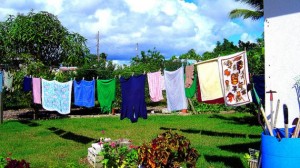Environmental friendliness started out as a push to reduce pollution and landfill space, but we now understand just how deep these effects can penetrate. While we may not always realize it, the way we live in our homes has a profound effect on the world outside. Energy consumption, waste products, even the cleaning products we use — it can all affect the environment, for better or for worse.
Although it might go overlooked in your home, the laundry room can be a huge suck of energy, using large amounts of electricity and water. If you’re looking for ways to reduce your resource consumption, you might have a lot of progress to be made just by going green in your laundry room. Here’s a quick guide to cutting costs and getting eco-friendly.
1. Upgrade to energy-efficient appliances
Older washing and drying units can be huge consumers of electricity and water. Fortunately, newer models are designed to improve efficiency. Seek out a washer and dryer that reduce energy consumption and minimize the amount of water used per load. Front-loading washers tend to be far more efficient than their top-loading counterparts. This swap alone could make a noticeable difference in your utilities bills. Look for a Samsung washing machine or another appliance manufacturer with a strong reputation for producing energy efficient products.
2. Wash clothes in cold water whenever possible
Heating your water comes at a cost, and many clothes don’t stand to benefit from a warm load versus a cold one. Some clothing will retain its colors longer by being washed in cold water. Whenever possible, aim to wash and rinse your loads in cold water. You won’t reduce your water usage, but you’ll save on heating costs, and that can add up.
3. Dry clothes on the line
Even if you have an energy-efficient drying unit, there’s really no appliance that can compare to the resource savings of simply drying clothes on the line. Air-drying takes a little more time and a little more space, but you can essentially render your dryer useless if you can commit to this change of habit.
4. Use less detergent, or make your own
The chemicals used in detergents may be safe for your skin, but they’re not necessarily the best thing for the environment. Detergent containers often recommend using more soap than you actually need in hopes of increasing detergent consumption — and, consequently, boosting their own sales. Cutting down on your detergent use won’t decrease the quality of your washing process, but it will let you get more mileage out of your detergent.
Conversely, you can make your own detergent and cut out some of the harmful chemicals found in detergents. All you need is a bar of soap, washing soda and borax and you can follow a simple recipe that helps you cut out your use of chemical detergents entirely.
After these changes go into effect in your laundry room, you should start noticing a difference in your resource consumption as it is expressed in your monthly utilities bills. Over time, the savings will add up, providing a great economic incentive to going green in your home. And in the process you’ll also be helping the environment and curbing the release of harmful pollutants into the atmosphere.
